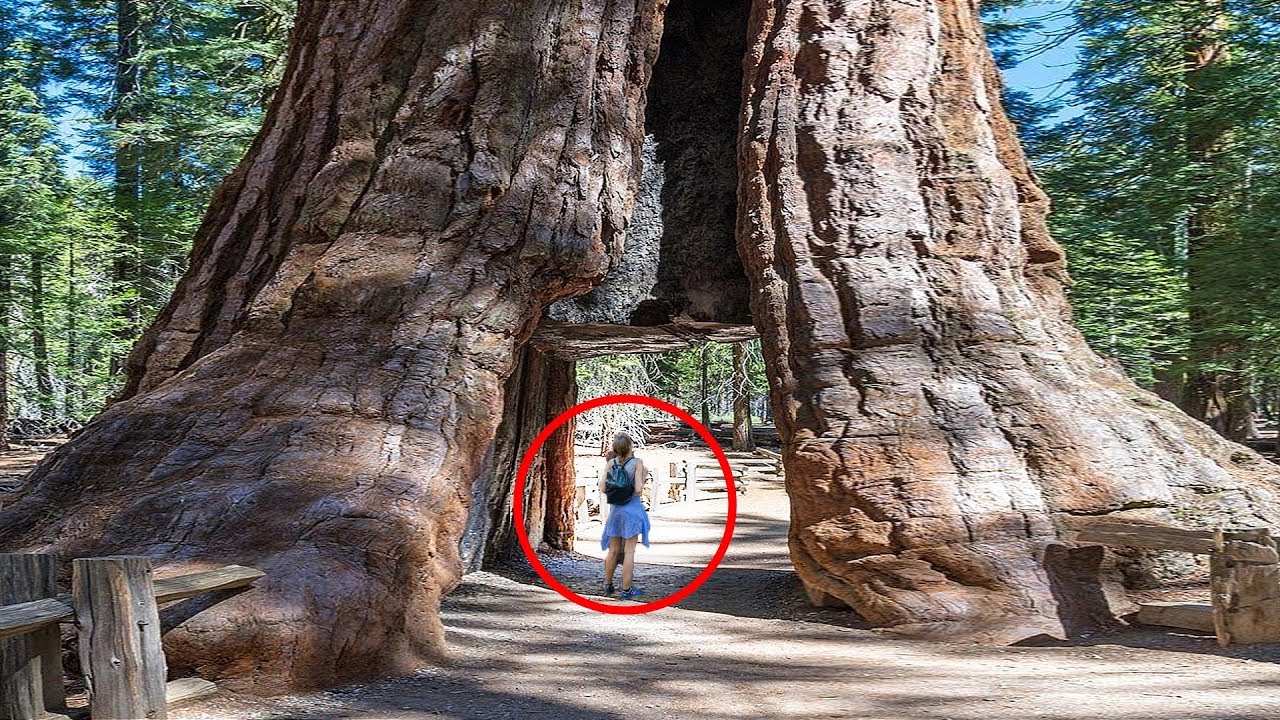The biggest trees in the world are a marvel in the wide fabric of nature that soars to unmatched heights and bears witness to the magnificence of our planet. These enormous trees, which seem to be living things, inspire fear and respect. Every massive example tells a different tale of tenacity and resiliency, whether it is found nestled amid the old redwoods of California or the towering sequoias of the Sierra Nevada.
We study these floral wonders’ remarkable dimensions, learn about their ecological significance, and consider the delicate balance necessary for their survival as we set out on a trip to discover them. Come along on this tour of the world’s biggest trees, which not only reach for the skies but also firmly ingrained in the natural history and ecosystem of our planet.

Quick Navigation
Discovering the Magnificence of the Biggest Trees in the World
Some giants are living examples of nature’s incredible strength, a testament to the wide and varied tapestry of ecosystems on our world. Known by the accurate name “the biggest trees in the world,” these marvels of nature are members of rare species that astonish those who are fortunate enough to experience their magnificence and defy expectations. This essay sets out to discover the mysteries surrounding these majestic sentinels, delving into their traits, ecological significance, difficulties they encounter, and current conservation initiatives.
Introducing Arboreal Giants: The Biggest Tree Species
The giant sequoias (Sequoiadendron giganteum) and coastal redwoods (Sequoia sempervirens) are the two iconic species that comprise the largest trees in the world. These massive plants, which are found in portions of Canada and California on the western coast of North America, draw attention due to their incredible tenacity and enormous size. Standing taller than their peers, they represent the pinnacle of arboreal splendor.
Read also: The University of Geneva | Total Review, History, Admission & Scholarships
Geographic Wonders: The Location of the Largest Trees
In particular geographical regions, the biggest trees in the world establish their own botanical refuges. The towering presence of coastal redwoods adds to the hazy atmosphere of the fog-kissed landscapes seen in southwestern Oregon and Northern California. However, the Sierra Nevada mountain range is home to the enormous sequoias, whose massive trunks dominate the surrounding terrain and extend as high as the sky.
Read Also: University of Miami Total Review | Programs, Scholarships, Admission & History
Climbing to New Heights: The Amazing Sizes of Tree Giants
We enter a domain of mind-boggling proportions when we discuss the biggest trees in the world. These towering trees often reach heights of over 300 feet, which are comparable to certain skyscrapers. Massive and magnificent, their trunks can reach diameters of more than thirty feet, producing an extraordinary botanical spectacle. Hyperion, a stunning 379.7-foot-tall coastal redwood, is one example of the amazing heights these trees may reach.
Massive Trees’ Function as Ecological Dancers in Ecosystems
The biggest trees in the world not only contribute significantly to the maintenance and development of their ecosystems, but also to their size. Serving as ecological dancers, they affect the climate, encourage biodiversity, and improve the state of the environment as a whole. For example, coastal redwoods are excellent at drawing moisture from the coastal air to create a special microclimate that is home to a wide variety of plants and animals.
Giant sequoias in the Sierra Nevada create a distinct ecological symphony. After a wildfire, their fallen cones release seeds that use the ash’s abundance of nutrients to encourage new growth. These trees maintain a delicate equilibrium in their forested domains by serving as essential habitats for a variety of species, including insects and birds.
Read Also: University of Washington Review – Programs, Admission & Scholarships
Breach in the Midst of Magnificence: Dangers to the Biggest Trees
The biggest trees in the world encounter significant obstacles despite their tenacity. Climate change makes environmental conditions worse, which puts their longevity and health at danger. The delicate equilibrium that these giants depend on can be upset by changes in temperature and precipitation patterns, leaving them vulnerable to pests and illnesses.
These antiquated guardians are also shadowed by human activity. Their natural habitats are disturbed by logging, urbanization, and fire suppression techniques, endangering the very ecosystems they support. Ensuring the survival of these floral gems requires an ever-more-delicate dance between preservation and progress.
Preservation Vital: Preserving the Forest’s Giants
Conservation efforts are being made to maintain and preserve the biggest trees in the world in light of the urgency of the problem. Modern tools like DNA analysis and aerial surveys help scientists keep an eye on these enormous creatures’ health. Together, local governments, environmental organizations, and communities are involved in collaborative programs that promote a shared commitment to their preservation.
Restoring and Preserving: A Future Direction for Arboreal Giants
In order to protect the biggest trees in the world, restoration and sustainability are also necessary. Projects to restore habitats are intended to establish conditions that will once again support these enormous creatures. To replicate natural processes and maintain the health of the forest ecosystem, controlled burns—a practice essential to the giant sequoia life cycle—are being used.
In order to preserve these old trees while also meeting community requirements, sustainable forestry practices are essential. Conservationists work to lessen the negative effects of human activity on the habitats of the largest trees by encouraging ethical logging and land management.
Read Also: The Different Types of Clouds
Educational Efforts: Promoting Sustainability for Upcoming Generations
Education is a crucial component in conservation. A sense of stewardship among communities is greatly influenced by initiatives aimed at increasing awareness of the importance of the biggest trees in the world. The goal of educational programs, guided tours, and interactive exhibits is to let people feel a deep respect for the delicate balance of nature by connecting them with the majesty of these arboreal treasures.
A Heritage Entwined with Environment: The Prospects for Arboreal Giants
It becomes clear that the world’s largest trees leave behind more than just massive trunks and towering canopies as we make our way through their rich tapestry. The biggest trees in the world are more than just impressive botanical specimens; they are living examples of how all life is intertwined, protectors of biodiversity, and environmental champions.
The joint efforts to save and maintain these arboreal behemoths represent a common dedication to the health of our world in the ongoing conservation story. The biggest trees in the world are a living tribute to the wonders of nature, serving as both silent timekeepers and engaged participants in the continuous story of life on Earth.
Which trees in the world are the largest species?
The Coastal Redwoods (Sequoia sempervirens) and the Giant Sequoias (Sequoiadendron giganteum) are the two magnificent species that are most commonly mentioned when discussing “the biggest trees in the world.” With their enormous size, these arboreal giants awe the viewer, appearing as titans among the vegetation.
Read Also: 12 best universities in San Francisco 2024
Geographically, where are these enormous trees located?
The biggest trees in the world, the Giant Sequoia and the Coastal Redwood, are indigenous to western North America. The Giant Sequoias find refuge in the Sierra Nevada mountain range, soaring for the heavens in magnificent forests, while the Coastal Redwoods thrive along the fog-filled northern California coast.
Which largest trees in the world usually grow to be how tall and wide?
Craning one’s neck to take in the magnificence of the tallest trees in the world is necessary. Coastal Redwoods reach heights of more than 300 feet; some of the tallest ones reach heights of more than 350 feet. Giant Sequoias, on the other hand, make up for their slightly smaller stature with its enormous girth—some of which measure over 30 feet in circumference.

What ecological functions do these enormous trees fulfill within their particular ecosystems?
The biggest trees in the world are not merely massive structures; they also serve as ecological cornerstones that are essential to the wellbeing of their respective ecosystems. Massive volumes of carbon dioxide are absorbed and stored by these arboreal giants, which is how they act as carbon sinks and contribute significantly to the mitigation of climate change. Within the towering branches of these canopies, a variety of flora and wildlife find a home as they form micro-ecosystems. Their roots also anchor the soil, halting erosion and preserving the health of the watershed.
What effects do human activities and the environment have on the wellbeing of these enormous trees?
The largest trees in the world are threatened by a variety of sources, notwithstanding their resistance. Their natural habitats are being impacted by higher temperatures and changed precipitation patterns due to climate change, which is a serious issue. These historic groves are being invaded by urbanization and logging, which is upsetting the delicate environmental balance. Air pollution presents other difficulties as well, affecting photosynthetic capacity and endangering the general health of the trees.
Recommended:
- Swiss Federal Institute of Technology (ETH Zurich) | History, Admission, Total Review
- Discover 11 Scholarships For Mature Students In Canada
- The Different Types of Clouds
- The University of Maryland | Programs, Admission, History & Scholarships
Exist any conservation initiatives aimed at shielding the largest trees from hazards and difficulties?
Large-scale conservation efforts have been implemented to guarantee the survival of the largest trees in the world since it is imperative to protect these botanical marvels. Governmental and conservation organizations work together to create protected areas, where logging is forbidden, and public awareness programs are meant to instill a sense of duty and respect for these amazing natural resources.
In order to ensure that future generations can marvel at the magnificence of the largest trees in the world, research into climate-resilient techniques and sustainable land management strategies adds to the continuing conservation efforts.
The biggest trees in the world, represented by the giant sequoias and coastal redwoods, are living legends that sustain ecosystems, pique people’s curiosity, and perfectly capture the delicate balance between human activity and the natural world. It is our joint duty as stewards of this planet to care for and safeguard these arboreal giants, ensuring their legacy is preserved for future generations. The biggest trees on Earth are not only magnificent in size but also serve as powerful reminders of our dedication to preserving the planet’s remarkable biodiversity.
SEE ALSO:
Trust you found our article on The Biggest Trees In The World helpful. Follow our website for more interesting articles.

